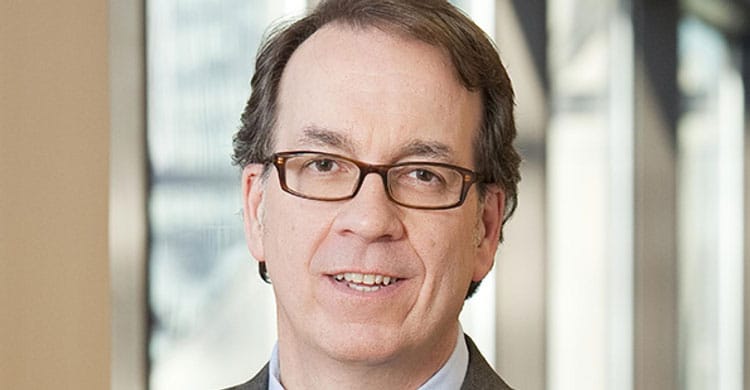At Natixis, John Hailer led an industry-wide shift in investment portfolio construction

At Natixis, John Hailer spearheaded initiatives that supported a wider evolution of investment portfolio construction. Currently, he maintains commitment and belief in this strategy.
Every investor knows the mantra of patience, long admonished to avoid trends and not follow the crowds. But then what? Having a long-term vision for your investments isn’t enough, said John Hailer, Chairman of Diffractive Managers Group, the fund arm of Boston-based 1251 Capital Group.
“It’s easy to tell investors that they should focus on the long-term. But as an industry, we need to get better at building the types of investment portfolios that help investors get there.”
For Hailer, this means real diversification that doesn’t just focus on returns but incorporates short- and long-term risk and volatility. Portfolios that can withstand the short-term ups and downs of markets keep more investors invested for the long-term.
“And we know that staying invested is one of the biggest drivers of long-term success,” said Hailer. “You can’t time the market, and you can’t sit out a downturn.”
Two classic examples are worth keeping in mind. First, the vast majority of the market’s best days occur during bear markets. Sure, you might think, “but aren’t I better off avoiding bear markets altogether?” Well, consider that if you missed the market’s ten best days over the past three decades your overall returns would be cut in half. How’s that for retirement risk?
“It’s pretty clear that the biggest risk most investors face is themselves,” said Hailer. “And it’s our job as an industry to help them make the right decisions today in order to make sure they and their families have the security they need later in life.”
‘If properly diversified, portfolios would’ve been more resilient.’
Fresh out of college, Hailer’s first employer, a storied Boston-based investment firm, adhered to the “Prudent Man” rule, promising to “never touch the principle,” a simple investment philosophy that made a big impact on Hailer and still drives him today
“The goal is to get some good solid returns but do it in a way where you’re not risking your life, you’re not risking your livelihood, you’re not risking all the things that are important to you. And you can do that with a well-built portfolio,” he said.
Originated by Massachusetts Supreme Court Justice Samuel Putnam in 1830, it established a standard of prudence based on “income and safety of principal with a view to the permanent disposition” of investor funds.
“This was essentially putting risk before return,” said Hailer. “The investment industry moved away from this, and frankly, lost its way a bit in the process.”
The result? When 2008 saw investors faced with the biggest financial market downturn in a generation, portfolios plummeted, savings were wiped out, and retirement plans were seriously curtailed.
“This never should’ve happened. If investors’ portfolios were properly diversified, we would’ve seen much more resilience,” he added.
The problem, Hailer explains, was that too many investors had been sold investment strategies – excellent in their own right – with too little regard for how these strategies fit in with the rest of their portfolio.
“A basket filled with every type of fruit imaginable is still just a basket of fruit,” Hailer quipped.
Fund ratings and financial advice
The ubiquitousness of fund classification systems, though well-meaning drivers of transparency, can also pose a challenge for individual investors seeking a well-constructed, properly diversified portfolio.
“Rating systems are great for transparency and great for investors,” said Hailer. “But investors need financial professionals to help them utilize them.”
For example, explained Hailer, consider a portfolio filled with the most highly rated funds across each category. Sound good? Not so fast. Such a portfolio makes two big mistakes, Hailer said. First, it’s built with returns as the primary input rather than risk. Second, it doesn’t fully account for how these funds work together, especially in market downturns.
The best portfolio construction looks at every investor and every portfolio as unique and considers an individual fund based on how it interacts with all the other holdings in the portfolio.
Putting investors first
Sounds simple, doesn’t it? Shouldn’t every business be putting its customers first? Too often, the asset management industry wasn’t, asserts Hailer.
“I don’t care whether you’re an executive, an employee, or a portfolio manager, the first thing that should come to mind is the person that gave us that dollar to invest. What are we doing with it? How are we protecting it? Are we fulfilling our fiduciary role?”
Often, in asset management, that means separating business strategy and money management.
“When a portfolio manager can do what she needs to do to manage money and not worry about the business equation, then she can put the investor first,” Hailer said.
Putting ideas into practice
Taking the reins shortly after the great financial crisis at Natixis John Hailer was determined to put his ideas into practice.
The company invested heavily in research, launching the Durable Portfolio Construction Research Center and radically expanding its business to include a global organization of sophisticated consultants mirroring its traditional fund distribution model.
The catch? The company’s new portfolio services were provided free of charge to investment professionals and were “product-agnostic,” recommending the investment strategies and products that were right for the client regardless of whether they were offered by Natixis or by a competitor.
“At the time, I took some grief over it, because companies need to run on financials. The idea that we were going to give away a free service, particularly one that would recommend competing funds, was controversial. But we showed that helping clients become better fiduciaries and helping them remain relevant in various market conditions, built a lot of trust. And trust is the backbone of all long-term successful businesses,” he concluded.
The market results were evident as Natixis grew from $130 billion to $900 billion in assets under management in 15 years and the program served as the vanguard for an investment industry sea change over the past decade.
Leading an industry in transition
Prior to Natixis, John Hailer served an eight-year stint at its predecessor, New England Funds, developing a consultative investment management approach that contrasted with the thriving technology markets’ return-focused approach.
When tech stocks eventually crashed during the early 2000s, investors took a renewed interest in New England Funds’ emphasis on analytics in building risk-focused portfolios.
“That market crash gave us an opportunity to get in front of researchers and gatekeepers and say, ‘Look, we have a different way to approach this. We have a different model. We were the first group out there that really went in with [what] we called durable portfolio construction. And we packaged it with the analytics needed to build a diversified portfolio that would help mitigate risks,” he said.
“By helping financial advisors better understand the interactions within their portfolios, we were able to help them make better investment decisions, get more consistent returns in their portfolios, and ultimately be better fiduciaries for their investors,” said John Hailer.
“Basically, what we were talking about was making the industry less sales-oriented. We weren’t just selling products. We were providing a service, helping brokers and institutions make better decisions for their portfolios and for their investors.”
Have you read?
Is Marc Benioff of Salesforce Right That You Can’t Integrate Junior Staff Without an Office Culture by Dr. Gleb Tsipursky.
The SUCCESS Side of Mergers and Acquisitions: Integrating YOU into Them … 25 Lessons Only Life Can Teach-You by Dr. Jeffrey Magee.
How to Profit from Genuine Customer Input – What to Never Say & Always Ask by Joseph A. Michelli.
Reimagining Luxury Post Covid: What Will It Look Like by Veidehi Gite.
Add CEOWORLD magazine to your Google News feed.
Follow CEOWORLD magazine headlines on: Google News, LinkedIn, Twitter, and Facebook.
Copyright 2024 The CEOWORLD magazine. All rights reserved. This material (and any extract from it) must not be copied, redistributed or placed on any website, without CEOWORLD magazine' prior written consent. For media queries, please contact: info@ceoworld.biz








